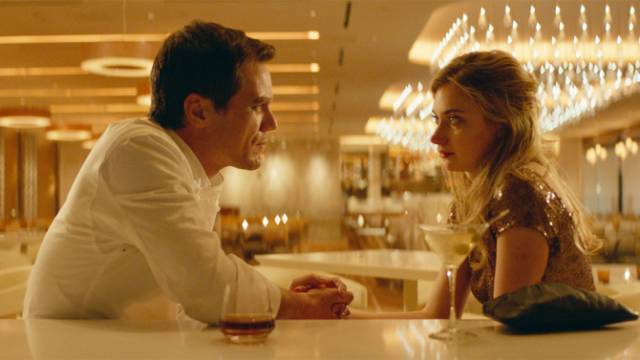
 Frank & Lola is a romance/thriller with a unique dual setting of Las Vegas and Paris. I’m not sure how many other movies share this distinction. Now You See Me, maybe? It’s an interesting juxtaposition: the gaudiness of the Vegas strip versus the nauseatingly classy visuals that we have come to associate with Paris. It’s not all about sharp contrasts either: Vegas has pretensions towards Paris. With the the Eiffel Tower and Arc de Triomphe shoe horned into the glitz of the strip, Vegas is like the glittering, obvious charlatan imitatingthe true thing. The interplay of the dual setting makes sense for a thriller about dissembling lovers. There is the genuine ideal and then there is the obvious imitation, which despite the artless fakery, is still irresistible.
Frank & Lola is a romance/thriller with a unique dual setting of Las Vegas and Paris. I’m not sure how many other movies share this distinction. Now You See Me, maybe? It’s an interesting juxtaposition: the gaudiness of the Vegas strip versus the nauseatingly classy visuals that we have come to associate with Paris. It’s not all about sharp contrasts either: Vegas has pretensions towards Paris. With the the Eiffel Tower and Arc de Triomphe shoe horned into the glitz of the strip, Vegas is like the glittering, obvious charlatan imitatingthe true thing. The interplay of the dual setting makes sense for a thriller about dissembling lovers. There is the genuine ideal and then there is the obvious imitation, which despite the artless fakery, is still irresistible.
The movie opens as Lola (Imogen Poots) and Frank (Michael Shannon) consummate their newly budding relationship. Frank is a rugged, soft-spoken chef, working the Vegas restaurant scene. Lola is a budding fashion designer. Their liaison is at first characterized by flirtatious non-sequiturs, emphasized by director Matthew Ross’s affection for allowing conversation to leak onto actions directly following or shortly before the words are uttered.
Their connection starts to falter slightly when Lola is offered a job through a smarmy business type (Justin Long) to whom Frank takes an immediate dislike. Things progress further downward as Lola’s inexplicably and very contritely betrays Frank. Michael Shannon plays Frank’s frustration wonderfully — his face (which has been popping up especially frequently lately, having starred in Midnight Special and coming up in Tom Ford’s sophomore outing Nocturnal Animals) seems to be designed for repressed but earnest male rage. The tension across his mouth anchored by deep face-framing creases holds maximum seething energy, like a spring-loaded trap.
Even if Frank is a live wire, his other qualities suggest he is the stand-in for plainness and honesty. His cooking style is characterized by unexpectedly basic dishes which manifest their excellence only after the first bite. Lola, meanwhile, is the sort of conniving dame whose every confession is a potential manipulative ploy. Then again, Frank’s plain food is misrepresentative in its own way — playing down its excellence, tucking caviar into the folds of an omelet.
So the metaphor introduced at the top of the article, with Paris as the genuine thing and Vegas as the garish double, needs to be refined. In true noir fashion, the dark underworld isn’t a distant contrast to the light, but right beneath it. There is no good city/bad city, honest lover/deceitful lover. They’re all intermingled. This is heartening in one respect. The love story doesn’t have to be all true or all false. Deceit doesn’t preclude love. You get to decide if this is troubling or reassuring.